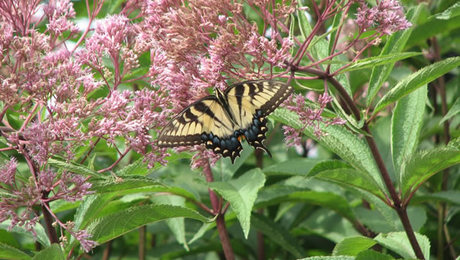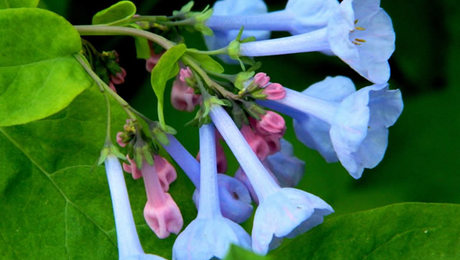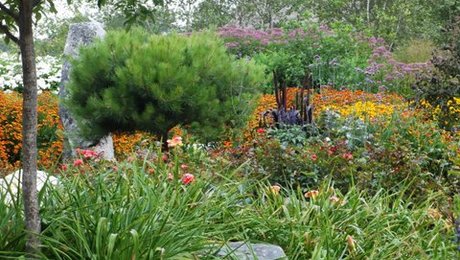
A huge thanks to Frank Greenhalgh for sharing this amazing space with us! Who's up for a trip down under?
‘If you are coming to Melbourne, Australia and wish to observe the beauty and wide diversity of Australian landscapes, flora and garden art in a day trip, make sure you visit the relatively new Royal Botanic Gardens in Cranbourne (45 km SE of Melbourne City Centre). The garden comprises 900 acres of bushland and wetlands. The centrepiece is the contemporary Australian Garden (37 acres), which showcases native plants in different environments and home garden styles. Features include the red sand garden, rockpool waterway and escarpment wall, exhibition gardens, arid garden, eucalypt walk and lakeside precinct. An open-air vehicle is available to transport people around the garden if challenged by the walk. So if you are in town, I as a keen gardener highly recommend that you come and enjoy and learn more about this special treasure (Photos. courtesy of the Royal Botanic Gardens)’.
Have a garden you'd like to share? Please email 5-10 photos and a brief story about your garden to [email protected]. Please include where you are located!
Have a mobile phone? Tag your photos on Instagram or Twitter with #FineGardening!
You don't have to be a professional garden photographer – check out our garden photography tips!
Do you receive the GPOD by email yet? Sign up here.



























Comments
Wow, now that is a s fairly alien landscape for me compared to what I garden with at my home. That red sand garden is fascinating. Thanks for presenting this unique garden, Frank. On the list when I make it down under.
Greetings David - Yes large parts of inland Oz. are arid areas/deserts. Most of the rainfall we receive is along coastal strips and there is a rain-shadow west of the Great Dividing mountain range down the east coast of the country. However, the wild flowers (e.g. in the SW of Western Australia) are absolutely spectacular when the arid regions receive sufficient rainfall etc. See comments I made to Michaele concerning the red sandy areas. Definitely worth a visit to the gardens when you travel down here! The Royal Botanic Gardens also has a lovely traditional garden in Melbourne, and you would be more familiar with the plants in those gardens - also worth a visit!
Looks like a fascinating public garden, Frank which will only become more and more interesting as plants grow and areas evolve. Could you share a little more on the idea behind the red sands section? Were the sands already in place or brought in to replicate what exists else where in Australia? Much of our natural "dirt" here in the southeast part of the US is that color but it clay rather than sand.
Hi Michaele - Many of the arid areas in Australia have red ochre landscapes. This is due to the level of iron oxide in the sandy soils. In fact, astronauts have often commented on how easy it is to identify Australia up in space due to the reddish colouration of much of the inland areas. Yes the sand was brought in to create a landscape typical of central Australia, and planted with flora found in these areas e.g. the Sturt's Desert Pea with its blood red leaf-like flowers and black bulbous centres (pictured).
I remembered that I had taken a picture of our TN dirt/soil to share with a friend so here it is in all its orange glory. Your sand has a more vibrant look to its coloration...maybe a little more hint of red to the tones.
Having grown up in black-soil Iowa, as a kid I brought home a big jar of red dirt from Georgia as an oddity-specimen to sit on my shelf!
Ha, so Georgia clay almost rivaled moon dust in its alien quality... at least to someone used to the beautiful black soil found in the midwestern farm states.
Thank you Michaele for the pic of your soil. Ochre is a natural earth pigment containing hydrated iron oxide, which ranges in colour (sorry about our spelling) from yellow to deep orange or brown. Evidently, a variant of ochre containing large amounts of hematite. or hydrated iron oxide, has a reddish tint known as red ochre. Here endeth the geology sermon Michaele.
What is the name of that cool plant in the red sand? This was a treat because we get to see other parts of the world and their triumphs and challenges. What are the temperatures there? It looks very hot, at least at times. I would give good money for some hot right now! Thanks, Frank!
Hello Rhonda - I'm glad you enjoyed the post. I wasn't sure how it would go down in your part of the world. The plant is Sturt's Desert Pea, which grows in arid regions in central and NW Australia. The Botanic gardens are near Melbourne which has a temperate climate, but many of landscapes represented at the gardens are dry (e.g. usually less than 10 inches of rainfall a year unless the rainfall from cyclones in the very northern part of the country move southwards) and experience very high temperatures in summer (often up to 45C and beyond e.g. over 50 degrees C - you do the conversions to degrees F - bloody hot no matter what temperature range you use!). I have read the recent posts in Fine Gardening and understand the frustration you guys are experiencing with your erratic weather. A big problem we face here is climate change - the country is going to become warmer and drier, and there will be more extreme events. Something we need to plan for with longer term garden designs and landscapes.
Rhonda: I am with you about wanting a little hot right now. We have been getting teased the last few days that temps here in Harrisburg were going into the upper 70's/low 80's this weekend. Forecast just revised for cloudy and mid 60's for the next week, with rain and a high of 56 on Saturday. Mother Nature foiled me again.
Thanks for sending this in, Frank. Absolutely spectacular in both design and plant matter. I've looked at this somewhere else online and was fascinated. Love the dessert pea and what look like grass trees or some such gorgeousness. It could almost tempt me to spend 22 hours in an airplane......Thanks for your info in the comments, as well. It is rather alien, and yet familiar. I've loved Australia in concept since a kid; from koalas to Ornithoptera!
Thanks for your comments Tim. Yes they are grass trees (Xanthorrhoea sp. - without the characteristic flowering spike - see attached pic. for those). There are approx. 30 species of grass trees, but all are slow growing. The specimens in the photo. would be hundreds of years old. They are very susceptible to root rot caused by the fungus, Phytophthora cinnamomi. Come on down and we will look after you. Plenty of great gardens to see in Victoria - the garden State of Oz.
I love this blog because we get to see so many different gardens, private and public, throughout the world. The variety of plants and planting styles is just so fascinating. New gardens are so cool to watch as they "grow up" over the first 10 years. I am sure you will enjoy seeing this, Frank. The red sand is such an interesting backdrop.
I hope to get to visit Australia some day. Definitely on my bucket list. Thanks for sharing this garden.
Hi Kevin - I also like the blog for the same reasons. I'm enjoying seeing the pics. and reading the narratives on Nth American gardens and your issues with the weather etc. We obviously have different weather issues. You need to get the trip off your bucket list - you won't be disappointed with the gardens! Oh - the company is OK as well!
Wow! I Love this! Great vision and wonderful new beginnings! Love the plants! So want to visit some day!
Hello there Jeanne - Yes it was a big and a different project - Botanic Gardens are usually more traditional and not as contemporary! Here are a couple more pics. to wet your appetite to come down and have a look for yourself. Thanks for your comments.
pics don't seem to have come through so here is another go Jeanne.
How cool is that! Loved the glimpse into this fascinating garden Frank. That dessert pea plant is so unusual. Thanks for sharing. Vikki in VA
Thanks Vikki - glad you enjoyed the garden. Let me tell you though, the climate in the arid landscapes represented at the gardens is not 'cool'. Yes Sturt's Desert Pea is a very bright and attractive plant in flower. It is the floral emblem of the State of South Australia. It doesn't grow naturally here in Victoria.
Thanks for sharing this, Frank! A huge part of this blog is the education it provides. We see so many familiar plants growing in much of the world, in places where one might not expect to find them. We don't often see gardens from the hotter areas, with their flamboyant exotic plants, many of which we try to keep going in our temperate zones. It is a rare treat to see something truly different like those desert and red sand scenes from the Royal Botanic Gardens.
G'day GrannyMay (it does have a ring to it!) - Thanks for your comments. So glad there is interest in our arid landscapes.
I've been fascinated with this garden for awhile now, especially what's shown in the first photo. Thanks for sharing!
Hi there Jay. Good on you for keeping up with gardening developments around the world. Cheers.
Absolutely fascinating Frank, the contemporary gardens are completely different than gardens we are are used to seeing and they are stunning. Many of the photos appeared to be taken from a higher elevation, are there raised walkways to allow this overview of the gardens as a whole? Love it... thanks for showing us a bit of Australian garden beauty. Very, very cool!
Glad you are fascinated Sheila with the RBG Cranbourne and Australian landscapes. Nice observation about the elevation - yes there are higher areas to take those pics.
Hi Frank, thanks for this interesting garden tour this morning. What an artistic display of landscape and hard scrape. We visited the Melbourne Botanical Garden last year but you're right in that it's more of the plantings that we are used to seeing and is also very beautiful, but this garden is exceptional. It looks like we're just going to have to make another trip. Oh darn:)
Thanks Linda for your comments. I'm very interested indeed that you visited the RBG in Melbourne city last year, and am wondering if you received any information there about the Cranbourne gardens i.e. was the new garden promoted during that visit? Hope you had a nice trip last time, but yes come back and see the RBG Cranbourne and some lovely gardens in the nearby Dandenong Ranges. We'll look after you!
Hi Frank, we only had one day in Melbourne, unfortunately, but had planned ahead to go to the RGB Melbourne. Had we known about Cranbourne, I'm almost certain we would have chosen to go there. Very short sighted of us not to research that better. We did manage a great day at the garden in the Blue Mountains on our way to Mudgee. That was a great discovery. We have a former exchange student in Sydney who we hope to visit again and next time, we'll allow more time in Melbourne as what we saw was impressive.
Thanks for at least making us feel like we were at Cranbourne., Linda and Dan O'Connell
So fascinating and other worldly! What a magnificent place, do you visit their often? It looks like it probably gets very, very hot there. It must have taken much time and labor to create the 37 acre show garden and what a beautiful addition to your city. Thanks
Hello Meelianthus - so glad you found it 'other worldly'. I have a 1acre vacation property on the Gippsland Lakes in eastern Victoria (which was featured on this blog a few months ago) and that keeps me busy so I don't visit the RBG Cranbourne as frequently as I would like. The climate at Cranbourne is similar to that in Melbourne i.e. temperate with some very hot days in summer. However, the climates in the arid landscapes represented at the Cranbourne gardens are very hot ones indeed i.e. desert climates. Yes it was a major job the RBG undertook to design, build and plant the gardens, and the Victorian government made a great investment in these gardens.
Thank you for that very interesting bit of history Frank.
Just catching up, somehow missed your wonderful garden pictures, Frank. How unusual they are and beautiful as well. What a job moving in the quantity of red sand it must have taken but so worth it. I would like to see it some day, but if that never happens I thank you for posting this educational collection, Frank,
Log in or create an account to post a comment.
Sign up Log in